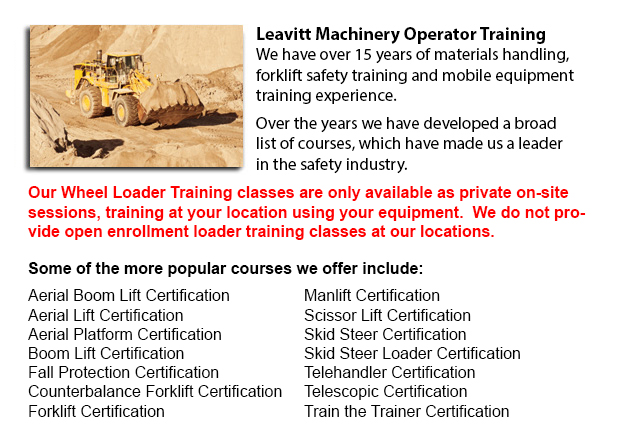
Sudbury Wheel Loader Operator Training - Cranes are industrial machines that use pulleys or levers to be able to pick up significant loads. The Roman people utilized cranes to be able to erect big monuments, meaning these machinery have been present for at least two thousand years. Many Medieval churches utilized cranes in their building and the Egyptian people might have relied on them when building the pyramids.
The modern version of a crane can be either complex or simple, and cranes differ depending on their application. Mobile cranes, for example are quite simple. A steel truss or telescopic boom mounts its movable platform. A system of pulleys or levers lifts the boom and there is normally a hook suspended. These cranes are frequently meant for demolition or earthmoving by changing the hook out with another piece of equipment such as a wrecking ball or a bucket. Telescopic cranes have a series of hydraulic tubes which fit together to form the boom. These models can even be mobile.
Conventional wheels, or certain wheels utilized for a caterpillar track or railroad track enable these mobile booms to be able to navigate uneven and unpaved surfaces.
Rough terrain and truck mounted cranes are mobile too. Outriggers are situated on the truck mounted unit in order to improve stability, while rough terrain cranes have a base that tends to resemble the bottom of a 4-wheel drive. These cranes are outfitted so as to operate on uneven surface making them ideal in the construction business for example.
Gantry cranes are utilized so as to transport and unload large containers off of ships and trains. They are usually seen functioning in railroads and ports. Their bases include very big crossbeams that run on rails to be able to raise containers from a spot to another. A portainer is a special type of gantry which transfers supplies onto and off of ships specifically.
Floating cranes are attached on barges or pontoons and are another essential piece of machinery vital to the shipping industry. In view of the fact that they are situated in water, they are used for a variety of services comprising port construction, building bridges and salvaging ships. Floating cranes could handle really heavy weights and containers and similar to portainers, they can also unload ships.
Loader cranes are fit onto trailers with hydraulic powered booms to load merchandise onto a trailer. If not being utilized, the jointed sections of the boom could be folded down. This particular kind of crane could be also considered telescopic as a section of the boom may telescope for more versatility.
Often used in automated warehouses, stacker cranes tend to follow an automatic retrieval system and can function using a remote. These cranes are outfitted with a forklift apparatus and could be found in big automated freezers, obtaining or stacking food. Using this kind of system allows staff to remain out of that freezing environment.
Tower cranes, often the tallest kind, typically do not have a movable base. They must be assembled part by part. Their base is similar to a long ladder together with the boom perpendicular to the base. These cranes specialize in the construction of tall buildings and are often affixed to the inside of the building itself throughout the construction period.
-
Wheel and Track Loader Training in Sudbury
Lift trucks are obtainable in several different models that have different load capacities. The majority of average forklifts used in warehouse environment have load capacities of 1-5 tons. Bigger scale units are utilized for heavier loads, like for... More -
Sudbury Aerial Lift Certification
Sudbury Aerial Lift Certification - Aerial Lift Certification is for individuals who requires an in-depth understanding of aerial lift safety. Inspectors and operators, supervisors, maintenance workers and construction craftsmen must perform a traini... More -
Sudbury Forklift Certification Schools
Sudbury Forklift Certification Schools - Within North America, forklift certification is mandatory, making forklift training programs necessary for both the company and their employees working as forklift operators. Forklift training focuses on healt... More -
Sudbury Boom Lift Operator Training
Sudbury Boom Lift Operator Training - A cherry picker refers to a type of aerial work platform. Cherry pickers include a platform or bucket at the end of a hydraulic lifting system. The device is likewise called a man lift, boom lift, basket crane or... More -
Sudbury Telehandler Certification
Sudbury Telehandler Certification - Telehandler certification programs are both for operators who have some experience driving a standard forklift and for those with no experience. The real-world training offered by these courses produces graduates w... More -
Operator Safety Training, Re-Qualification Training, In-House Instructor Training in Sudbury
Lift trucks are utilized in just about all industrial construction sites and in warehouse operations and in boat yards. The reach feature of a lift truck is a vital component used in several applications like for example when a shelving system is bei... More -
Crane / Overhead Crane / Self-Erect Crane / Truck Mounted Crane / Hydraulic Cranes Training in Sudbury
Bridge cranes or overhead cranes are a type of industrial material handling crane making use of a line and hook apparatus which runs on a horizontal beam running along two widely separated rails. Lots of overhead cranes could be seen in a long factor... More -
Sudbury Forklift Safety Training
Sudbury Forklift Safety Training - Anyone who wants to operate a lift truck should take a forklift safety training course in order to become a certified forklift truck operator. There are a variety of ways to obtain forklift training. Programs are pr... More

Forklift Certification Sudbury
TOLL FREE: 1-888-254-6157
Sudbury, Ontario
forkliftcertificationsudbury.com
Email Us
About Us


